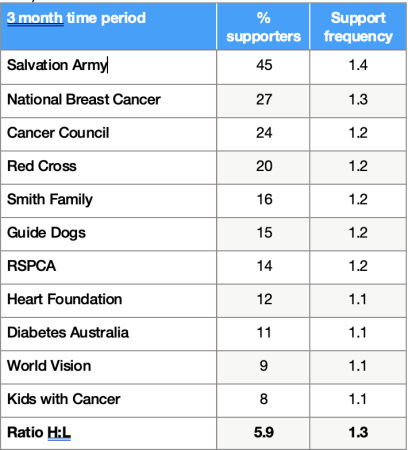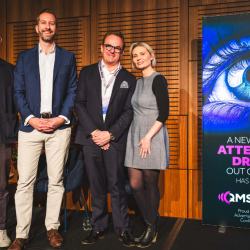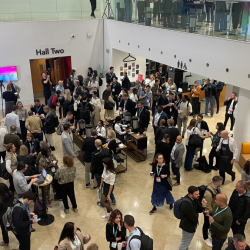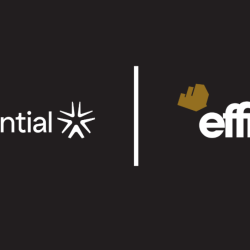This column is for all the non-profit marketers out there, who are using their own ‘people power’ to improve our world. Some of the most inspiring marketers I have met work for non-profits. Money for their cause is usually hard won, and so they face constant pressure to make sure every penny is spent wisely. This combination of passion and resource challenges are why it is especially disheartening to see non-profit marketers deplete resources trying ineffective marketing strategies. Marketers in the non-profit sector are hampered by a lack of supporter-centric data, and limited research budgets. While a non-profit marketer might not have their own data to learn from, they can learn from marketing science, and in particular the Laws of Growth in How Brands Grow.
The Laws of Growth help us understand how buyers buy and how brands compete, showing us how (and how not) to grow brands. Where possible, we have tested these laws (and other findings) in the context of non-profit brands. Here are some of the results:
The law of Double Jeopardy (DJ)
This law questions the idea that loyalty-first marketing can drive brand growth. It says small brands suffer twice, with many fewer buyers who are less loyal when compared to the buyers of bigger brands. DJ also occurs in the non-profit sector, as shown in Table 1 where World Vision has one fifth the supporters of The Salvation Army, but only 0.3 less frequency of support. Which means that if a non-profit wants more support, it should prioritise recruiting more supporters, rather than building loyalty or cross selling to existing supporters.

Ehrenberg’s Law of Buying Frequencies
This law reveals that in markets where people buy multiple brands, most buyers in any brand’s customer base are ‘light’ and only buy once or twice. Figure 1 shows how this holds for donations of money and blood. While Light donors don’t contribute much per person, there are so many of them they are a very valuable segment.
Therefore it’s time to thank the light donor and be happy with what they give, rather than wasting resources trying to make them give more. Another challenge for non-profit marketers is making it easy (and cost effective) for someone to give a little, infrequently!

The Duplication of Purchase Law
This law calls into question the value of segmentation and targeting, as it reveals brands predictably share customers with other brands. All brands share more customers with the bigger brands and fewer customers with the smaller brands. This law also holds for non-profit brands, and even across different causes. As Table 2 shows, every non-profit is more likely to share donors with Goodwill and Salvos and less likely to share donors with YMCA or Girls & Boys Clubs.
Therefore if you are a small non-profit, your biggest competitors are not other small non-profits solving similar issues, but rather the bigger non-profits irrespective of their cause. This opens up the opportunity for more collaboration between similar but smaller non-profits to help them be more competitive in the wider market.

It’s a start, but more work still to be done….
Here are three empirical laws developed on for-profit brands that also apply in the non-profit sector. Chances are there are many more, we just need the data to test them. We also need more evidence to work through the implications of these laws to the non-profit sector.
The good news is we are off to a promising start, these results show that non-profit sector doesn’t need laws unto its own, but can draw on the strong foundations developed in other categories where data is more readily available. The Ehrenberg Bass Institute’s work in this area continues — shout out to Dr Margaret Faulkner and Dr Cathy Nguyen who are amongst the researchers we have in the non-profit space.
The Ehrenberg-Bass Institute’s event series, How Brands Grow – for Executives, will take place in Bordeaux, France on 17-20 June 2024 and in Boston, USA on 9-12 September 2024.
Key references
Faulkner, Margaret, Jenni Romaniuk, and Philip Stern (2016), “New versus frequent donors: Exploring the behaviour of the most desirable donors,” Australasian Marketing Journal, 24 (3), 198-204.
Faulkner, Margaret, Jenni Romaniuk, and Philip Stern (2023), “How sharing of supporters reveals competition amongst non-profit brands,” Journal of Marketing Management, 39 (3-4), 193-212.
Nguyen, Cathy, Margaret Faulkner, Song Yang, John Williams, and Luqiong Tong (2022), “Mind the gap: Understanding the gap between intentions and behaviour in the charity context,” Journal of Business Research, 148, 216-24.
Nguyen, Cathy and Margaret Faulkner (2020), “In pursuit of effective charity advertising: Investigating the branding and messaging execution tactics used by charity marketers,” Third Sector Review, 26 (1), 66-87.
Sharp, Byron (2010), How Brands Grow. South Melbourne: Oxford University Press.
Stern, Philip and Margaret Faulkner (2012), “Do Charities comprise a Dirichlet Market?,” in ANZMAC. Adelaide: Australian and New Zealand Marketing Academy.
Featured image: RDNE Stock Project / Pexels































